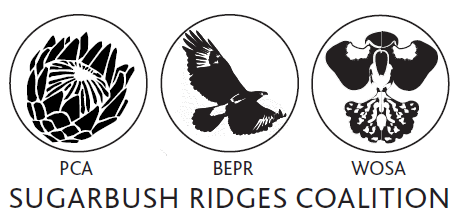Result of Field Trips during 2nd Conference 2017
Dullstroom
20th and 22nd January 2017

Orchid Hunting on the White Ridge
Notes:
1. Morphologically this cross appears to be between Disa versicolor and Disa rhodantha.
2. The McMurtry et al concept of Eulophia hians "aestivalis" form and Eulophia hians var. nutans is difficult to distinguish at this time of the year. Normally the "aestivalis" form on Verloren Valei flowers earlier and the spikes are short. I decided the plant my group saw was rather E. hians var. nutans, although the colour pointed to the "aestivalis form". Johnson et al would consider the plant as E. hians var. nutans.
Factors affecting flowering of the terrestrial orchids
A number of factors may influence whether a terrestrial orchid will flower or not.
Fire has been recorded as influencing and, in some cases, to be necessary for the flowering of some terrestrial orchids.
Whether the plant is large enough to flower is another factor.
Soil temperature during summer and winter may influence the initiation of flowers.
The past two seasons are of interest. Researching terrestrial orchids is not that easy. I think we should report what we found so that future researchers may benefit from our observations. The climate in the 2015 - 2016 summer was different from other years in that rainfall was considerably less than the average and summer temperatures were quite a bit higher than normal. I think the winter was also warmer than usual. This information should be available from the Reserve Management. Then in 2016 no blocks were burnt. Only the fire-breaks were burnt. The burning of the fire-breaks can be used to some extent, as control, but unfortunately the burning of the fire-breaks occur too early in the season - late autumn (May) or early winter (beginning June). Burning this time of the year may be detrimental to some, especially, later flowering orchids.
The following remarks are relevant in this context.
3. Disa rhodantha habitat is the edge of streams, marshes and wet grassland. Drought may influence the development of the new tuber. It may be too small to support flowering. I visited a number of the localities of D. rhodantha and found very few plants. As the localities are all wet, the lack of fire this season is most likely the reason why only a few plants flowered. However, two colonies were on a fire-break, but in wet grassland. Those colonies did not flower well. The grassland may have been too dry during the drought, affecting the development of tubers in that season. The warmer winter may also have influenced the initiation of flowering.
4. The Disperis wealei colony was a surprise. With over 30 plants in flower in a small area slightly away from its normal habitat - was really something to see. We did not find plants in flower along the Lunsklip River. This may be due to flooding of the river, which could clearly be seen in the grass along the river.
5. Very few of these two species - Satyrium hallackii subsp. ocellatum and Satyrium longicauda - were in flower. However, a lot of flower spikes could be seen. The impression however, is that it will be less than in 2016.
6. Schizochilus zeyheri normally grows along watercourses, marshes and seasonally wet grassland. Few flowering plants were seen in its normal habitat. However, we found a colony in a wet part of a fire-break. The colony was flowering well, indicating the importance of fire.
In summary, understanding the flowering of terrestrial orchids is a complex matter. In some cases dependence on fire could be derived and in other cases fire did not play a role in their flowering. Some species were more affected by the previous season's climate than other species, while others showed little effect.
The following species were found in flower outside the time frame or area of the two field trips:
| No | Name | Comment On Plants Flowering |
| 1 | Corycium dracomontanum | Less than 2016. |
| 2 | Corycium nigrescens | Less than 2016. |
| 3 | Disa aconitoides | Always rare. End of flowering period. |
| 4 | Disa alticola | In fire-break and in seepage - same as in 2016. |
| 5 | Disa brevicornis | Far less than last year. Normally flowers erratically. |
| 6 | Disa cooperi | Less than 2016, but not by much. |
| 7 | Disa nervosa | Always rare and found sporadically on the Reserve. |
| 8 | Disa rhodantha | Very few plants compared to last year. Main reason(s) drought/lack of fire? |
| 9 | Disa saxicola | Similar to 2016, maybe slightly less. |
| 10 | Disa stachyoides | Very late flowering. Far less than 2016. |
| 11 | Disa versicolor | Almost the same as last year. |
| 12 | Disa cross¹ | New. |
| 13 | Disperis cardiophora | Difficult to find. Less than 2016. May still bloom better later |
| 14 | Disperis renibractea | Not too difficult to find. Considerably less than 2016. |
| 15 | Disperis tysonii | Maybe late, but appears to be far less than 2016. |
| 16 | Disperis wealei | New large colony. Impression is that they are more abundant, but scarce along the river. |
| 17 | Eulophia hians “aestivalis”² | End of season. Less than 2016. |
| 18 | Eulophia hians var. nutans | End of season. Less than 2016. |
| 19 | Habenaria clavata | Sporadic on the Reserve. |
| 20 | Habenaria dives | Similar to 2016, maybe slightly less. |
| 21 | Neobolusia tysonii | Less than 2016. |
| 22 | Orthochilus foliosus | End of Season. Nice big colony. |
| 23 | Orthochilus leontoglossus | Sporadic on Reserve. |
| 24 | Orthochilus welwitschii | Recent discovery on Reserve (2011). Sporadic |
| 25 | Satyrium cristatum var. cristatum | Less than 2016. |
| 26 | Satyrium hallackii subsp. ocellatum | Far less than 2016. Still a lot of spikes. Late flowering? |
| 27 | Satyrium longicauda | Far less than 2016. |
| 28 | Satyrium longicauda var. jacottetianum | More than 2015. |
| 29 | Satyrium parviflorum | Far less than 2016. |
| 30 | Satyrium trinerve | Already scarce in 2016. Now even rarer |
| 31 | Schizochilus cecilii subsp. culveri | Same as 2016. The two colonies that I monitor are very similar. |
| 32 | Schizochilus zeyheri | Less than 2016. Away from fire-break far less than 2016. In fire-break, similar. |
|
The following species were found in flower outside the time frame or area of the two field trips: |
||
| 33 | Disa patula var. transvaalensis | On the Reserve. Compared to last year it appears to be either late or severely affected by the drought and/or the absence of a fire. |
| 34 | Eulophia parvilabris | Outside Reserve, but not far away. Colony was flowering better than last year. |
| 35 | Habenaria cornuta | Outside the Reserve. |
| 36 | Orthochilus odontoglossus | Outside the Reserve at a lower altitude. |
|
The following plants that had finished flowering, but still identifiable, were found. |
||
| 37 | Disa chrysostachya | Less than 2016 |
| 38 | Holothrix scopularia | |
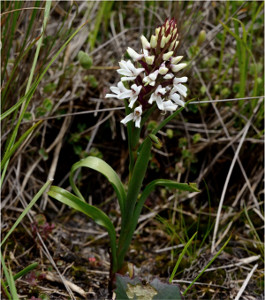 |
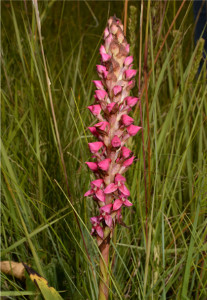 |
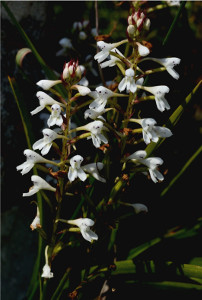 |
| Disa Altocola (GvE) | New Disa Hybrid (KW) | Disa Saxicola (GvE) |
 |
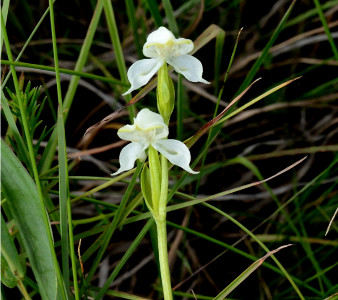 |
 |
| Orthochilus odontoglossus (GvE) | Disperis wealei (GvE) | Habenaria clavata (GvE) |
Compiled by Gerrit van Ede.

